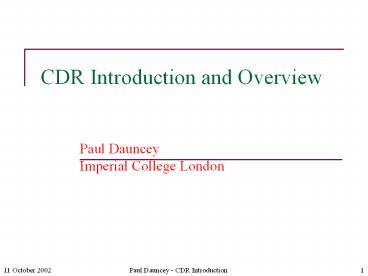CDR Introduction and Overview PowerPoint PPT Presentation
Title: CDR Introduction and Overview
1
CDR Introduction and Overview
Paul Dauncey Imperial College London
2
Main aim of CALICE is a beam test
- Electromagnetic (ECAL) and hadronic (HCAL)
calorimeters - Final aim is for a linear collider after 2010
- Test prototypes in beam starting in mid 2004
- Several tests, running (not continuously) for
around 1 year in total - UK proposal to build ECAL back-end readout
electronics - Front-end electronics supplied by Orsay/Paris
group - No proposals for HCAL back-end yet
- Front-end not very firm but some effort there
- Adapt ECAL readout electronics for HCAL back-end?
- No proposals for trigger, beam monitoring, etc,
either - Need to be flexible to accommodate uncertainties
here
3
ECAL system
- 1?1cm2 silicon diode pads, each diode is a
channel - 18 ? 18 diodes 324 channels/layer
- 30 layers 9720 channels
- Front-end electronics is VFE chips on VFE-PCBs
- 6 chips/PCB, 18 channels/chip and 108
channels/PCB - VFE chip is charge integrating amplifier with
CR-RC shaper - Requires 14 bits dynamic range, 10 bits
resolution - The 18 channels/VFE chip are multiplexed onto one
output line as analogue voltages - Readout needs to digitise signal at peak 180ns
- VFE has calibration circuit to inject charge at
input stage
4
VFE-PCB interface
- Interface is at VFE-PCB connector
- Time dependent signals through connector shown
below - Sample-and-hold timing critical, needed to 10ns
- All others less severe, needed to 100ns
5
Trigger interface
- Trigger using scintillators in beam
- Trigger logic not completely trivial
- Need to hold off further triggers until each
event read out - Need to be able to veto trigger if too close
(1ms) to last activity - Need to be able to abort trigger if activity soon
(100ns) after trigger - Need to know if beam present or not
- Need several types of trigger (beam, cosmic,
calibration, pedestal, etc.) selectable from DAQ - Also (potentially) need trigger fan-out to HCAL
readout with adjustable delay - No proposal for a CALICE group to build this
(yet) - Have to retain large degree of flexibility given
uncertainties here - Some/all of logic could be built into readout/DAQ
system
6
Data acquisition interface
- Need to read all channels for every event
- Could do threshold suppression in principle
- Need to see pedestals and noise at least in some
subsample - Allow for inclusion of HCAL, trigger and beam
monitor - Event numbers required
- Need around 200 set-ups (particle types,
energies, HCAL options, entrance angles, etc.) - Need 3?105 events for each set-up
- Total sample 6?107 events
- Rates required to take these events in a
reasonable time - Need around 100 Hz sustained rate
- Given beam structure, this requires around 1kHz
peak rate - Data sizes event will be around 25 kBytes
- Total data size around 1.5 TBytes
7
Proposed system
- Cables from VFE-PCBs direct to 15 VME readout
boards - External trigger to 1 VME trigger board, then
distributed via customised backplane - Also need a test board for debugging readout cards
8
HCAL implications
- There are (at least) three HCAL options
- Analogue readout scintillating tiles, 1500
channels - Digital readout RPCs or GEMs, 350k channels
- Analogue option may use VFE chip (on different
PCB) - Simple (in principle) to use same readout
electronics - Not clear if all 18 channels/VFE chip used in
this option - Minimum of 3 extra readout boards needed, maybe
more - Digital options will share front-end readout
- 38 layers, each with zero suppression at
front-end - Expected total event size around 2kBytes
- No proposal for back-end electronics also use
ECAL readout? - Basically need an LVDS I/O data path
- Minimum of 7 extra readout boards needed, maybe
more - Need to allow for multiple crates and at least
two trigger boards
9
VME crate specifics
- Customise crate for trigger and addressing
- Use some of 64 spare pins on J2
- Four LVDS signals bussed on backplane
- System clock (12.5MHz)
- Trigger
- Two spares
- Geographical slot addressing
- Six TTL pins with unique value for each slot
- Six bits are needed to cover two crates 42
slots - Power supplies need 3.3V rather than 5V
- For LVDS I/O signals
- FPGAs run at 1.8V or 2.5V, stepped down from
3.3V - May be issue with non-UK readout (beam
monitoring, etc)?
10
Summary
- External interfaces are still in flux
- VFE-PCB reasonably firm
- Trigger and HCAL very uncertain
- Basic system concept laid out here
- Will have to react to changes in interfaces
- Hopefully no major architectural changes needed
- Following talks lay out proposed system in more
detail - Readout and trigger board internals
- Final talk will discuss cost, effort, schedule

